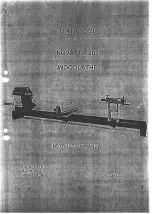
17
Copyright © 2020 Quality Machine Tools, LLC
PM-1440GS v3 2020-10
COMPOUND SETUP FOR THREAD CUTTING
Thread cutting on the lathe is unlike most other turning opera-
tions, for two reasons: 1. The cutting tool must be precisely
ground with an included angle of 60 degrees for most Ameri-
can and metric threads, and; 2. It is preferable to feed the tool
into the workpiece at an angle so it cuts mostly on the left flank
of the thread. The correct angle relative to the cross slide (zero
degrees) is a subject of debate — should it be 29, 29-1/2 or 30
degrees? Many machinists prefer 29 degrees because it holds
the cutting tool marginally clear of the right flank of the thread,
close enough for cleanup of the flank while at the same time
avoiding appreciable rubbing.
The 45
o
- 0
o
- 45
o
scale on the compound is not directly helpful
in setting the thread cutting angle, but it can be used for that
purpose if a second reference mark is applied to the cross
slide. First make certain that the compound is truly aligned
with the lathe axis when 0
o
on the scale is on the cross slide
Figure 3-18
Setting up the compound for 30
o
infeed
A new reference mark is stamped on the cross slide at 30 degrees.
To set the compound for thread cutting, rotate it clockwise to bring the
right hand 30
o
scale mark in line with the new reference mark. For 29
o
rotate the compound 1 degree more.
For metric and UNC/UNF threads the tool is ground to 60
o
(in
-
cluded angle). It is installed so that its flanks are exactly 30
o
either side of the cross axis, ideally with the compound off
-
set as Figure 3-18. Single-point threads are cut in 10 or more
successive passes, each shaving a little more material off the
workpiece.
To make the first thread-cutting pass the leadscrew is run at
the selected setting (table on page 15), and the carriage is
moved by hand to set the cutting tool at the starting point of the
thread. With the tool just grazing the workpiece, the split-nut
lever is lowered to engage the leadscrew. This can be done at
any point,
provided
the split-nut remains engaged throughout
the
entire multi-pass process
.
When the first pass is completed, the tool is backed out clear
the workpiece (using the cross slide), and the spindle is re
-
versed to bring the saddle back to the starting point. The cross
slide is returned to its former setting, then the tool is advanced
a few thousandths by the compound for the next pass. Each
successive pass is done in the same way, each with a slightly
increased infeed setting of the compound.
Many users working on U.S. threads save time by disengag-
ing the split-nut at the end of each cutting pass, reversing the
reference mark — do this by indicating against a ground bar
between centers while advancing the indicator using only the
compound. Allow for the variance, if any, when applying the
new reference mark. Grind a chisel edge on a 1/4 in. square
HS tool bit, align it precisely on the left hand 30
o
scale mark;
then rap the tool bit sharply with a hammer.
CUTTING PROCEDURE FOR TPI THREADS
This procedure assumes that a single point thread cutting tool
will be used, and that the threading dial assembly has been
pivoted forward to engage its worm wheel with the leadscrew,
Figure 3-19.
The threading dial cannot used for metric threads! The
split-nut on the apron must be left engaged throughout
the entire process.
Figure 3-19
Threading dial







































